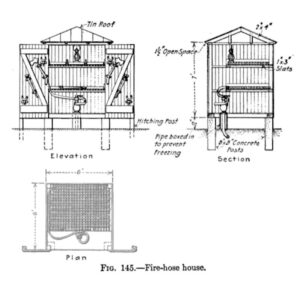From Google Books: Maintenance of Way and Structures by William Clyde Willard published 1915 .. from Page 276
“Where several railway buildings are grouped, a fire-hose house is often built. This contains axes, wrenches, etc., a hydrant to which the hose is already attached. A fire-hose house built by the Baltimore and Ohio Railroad is shown in Fig. 145.”
HYDRANT HOUSES AND EQUIPMENT
- Hose houses over yard hydrants enable hose to be kept connected and folded upon shelves ready for immediate use. Where there is no trained brigade, or during night fires, or at time of heavy snow, the advantages of hose houses are particularly great. To give an idea of-the relative rapidity with which fire lines can be laid and water turned on, it can be stated that with a good hydrant and hose house equipment the first stream can usually be obtained in about 30 seconds, and two or three minutes are required where a cart has to be run up, hose coupled to hydrants, run out, nozzle attached, and water turned on.
- Hose or other appliances kept inside of a building may be inaccessible at the time of fire. Heated buildings cause cotton rubber-lined and rubber hose to deteriorate more rapidly.
- Generally speaking, hose houses should be erected over all hydrants, or at least over those near important buildings. The detailed data and illustrations on the following pages are selected from the rules of the National Board of Fire Underwriters, which should be closely followed if the best results are to be obtained. The principal features are protection against the weather and ventilation, the ventilation being secured through slatted floor and shelves and vent spaces under overhanging roof, so arranged that rain cannot drive into building.
- Hose is generally attached to one of the hydrant outlets, leaving one or more available for additional lines, which can be laid from a hose cart, or from reserve hose in the house. Sometimes double hose equipments are connected to one hydrant. One shelf in a standard hose house will carry 150 ft. to 200 ft. of single-jacketed cotton rubber-lined hose folded forward and back. ‘ So placed it will ventilate and can be readily inspected.
- Where the conditions are such that it is necessary to lock hose houses, this can be accomplished by using a special lock with a brittle shackle, or by having a latch placed behind a glass plate which can be broken at time of fire.
- The National Board Rules show five-sided and foursided houses. The advantage of the former is somewhat greater accessibility of the hydrant. Generally, however, the four-sided house is easier and a little cheaper to build, and entirely satisfactory if made full size. Fig. 60 shows the framework of the five-sided house, and Fig. 6! the equipped four-sided one. From these views suitable buildings can be erected.
- The usual equipment for a hydrant house consists of:
150-250 ft. of cotton rubber-lined hose.
2 Underwriters’ play pipes, 30 ins. long, with swivel handles,
and 1-1/8-in. smooth-bore tips.
4 to 6 Tabor spanners.
2 fire axes, weighing about 6 lbs. each.
2 1-1/4-in. X 5-ft. crow bars.
2 canvas ladder straps.
1 extra hydrant wrench.
I heavy mill lantern kept filled.
4 to 6 extra washers for hose couplings.
I hand line of 5/8-in. Manila rope, long enough to reach roof of highest building to which department might climb.
Authors’ Note: Operating “ wrinkles” in connection with hose house equipment include:
a—Soaking axe helves in hot linseed oil to avoid shrinking of the wood. _
b—Where there is more than one size of hydrant or indicator post nut, using a fiat bar hydrant wrench with holes to fit all nuts.
c—Using lanterns with well protected glass fonts so as to permit telling at a glance if fonts are full of oil.

